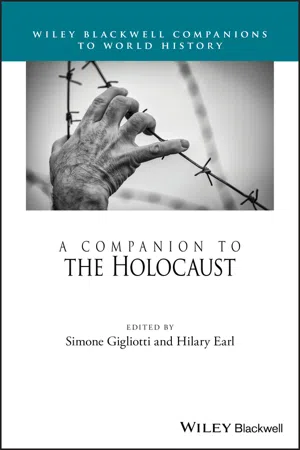
- English
- ePUB (mobile friendly)
- Available on iOS & Android
A Companion to the Holocaust
About this book
Provides a cutting-edge, nuanced, and multi-disciplinary picture of the Holocaust from local, transnational, continental, and global perspectives
Holocaust Studies is a dynamic field that encompasses discussions on human behavior, extremity, and moral action. A diverse range of disciplines – history, philosophy, literature, social psychology, anthropology, geography, amongst others – continue to make important contributions to its scholarship.
A Companion to the Holocaust provides exciting commentaries on current and emerging debates and identifies new connections for research. The text incorporates new language, geographies, and approaches to address the precursors of the Holocaust and examine its global consequences. A team of international contributors provides insightful and sophisticated analyses of current trends in Holocaust research that go far beyond common conceptions of the Holocaust's causes, unfolding and impact.
Scholars draw on their original research to interpret current, agenda-setting historical and historiographical debates on the Holocaust. Six broad sections cover wide-ranging topics such as new debates about Nazi perpetrators, arguments about the causes and places of persecution of Jews in Germany and Europe, and Jewish and non-Jewish responses to it, the use of forced labor in the German war economy, representations of the Holocaust witness, and many others. A masterful framing chapter sets the direction and tone of each section's themes. Comprising over thirty essays, this important addition to Holocaust studies:
- Offers a remarkable compendium of systematic, comparative, and precise analyses
- Covers areas and topics not included in any other companion of its type
- Examines the ongoing cultural, social, and political legacies of the Holocaust
- Includes discussions on non-European and non-Western geographies, inter-ethnic tensions, and violence
A Companion to the Holocaust is an essential resource for students and scholars of European, German, genocide, colonial and Jewish history, as well as those in the general humanities.
Frequently asked questions
- Essential is ideal for learners and professionals who enjoy exploring a wide range of subjects. Access the Essential Library with 800,000+ trusted titles and best-sellers across business, personal growth, and the humanities. Includes unlimited reading time and Standard Read Aloud voice.
- Complete: Perfect for advanced learners and researchers needing full, unrestricted access. Unlock 1.4M+ books across hundreds of subjects, including academic and specialized titles. The Complete Plan also includes advanced features like Premium Read Aloud and Research Assistant.
Please note we cannot support devices running on iOS 13 and Android 7 or earlier. Learn more about using the app.
Information
Theme 1
New Orientations and Topical Integrations
Chapter One
“Final Solution,” Holocaust, Shoah, or Genocide? From Separate to Integrated Histories
The First Histories
The record must be hurled like a stone under history’s wheel in order to stop it….One can lose all hopes except the one – that the suffering and destruction of this war will make sense when they are looked at from a distant, historical perspective. From sufferings, unparalleled in history, from bloody tears and bloody sweat, a chronicle of days of hell is being composed which will help explain the historical reasons for why people came to think as they did and why regimes arose that [caused such suffering].4
Table of contents
- Cover
- Table of Contents
- Notes on Editors and Contributors
- Introduction
- Theme 1: New Orientations and Topical Integrations
- Theme 2: Plunder, Extermination, and Prosecution
- Theme 3: Reframing Jewish Histories
- Theme 4: Local, Mobile, and Transnational Holocausts
- Theme 5: Witnessing in Dialogue: Testifiers, Readers, and Viewers
- Theme 6: Human Rights and Visual Culture: Pivots and Disruptions
- Index
- End User License Agreement